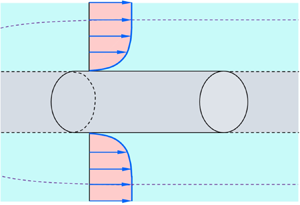No CrossRef data available.
Article contents
Universal law of skin-friction coefficient in a fully developed zero pressure gradient axisymmetric turbulent boundary layer flow
Published online by Cambridge University Press: 31 October 2023
Abstract

Understanding the skin friction in an axisymmetric turbulent boundary layer (ATBL) flow is a key to designing and optimising the flow past axisymmetric bodies, for example, a rocket engine nozzle and a submarine hull. In this study, we propose a universal law of the skin-friction coefficient in an ATBL flow. The flow is steady and fully developed with a zero pressure gradient. The governing equation for the ATBL flow is derived by methodically applying the boundary layer approximation. Subsequently, the scaling law of the Reynolds shear stress, caused by turbulent eddies, at the surface tangential to the wall roughness summits is derived by incorporating the role of transverse curvature. The skin-friction coefficient in a smooth ATBL flow is found to depend on two parameters, namely, the Reynolds number based on the cylinder radius, Rea, and the ratio of boundary layer thickness to cylinder radius, δ/a. The analysis predicts a simple form of the skin-friction coefficient as  ${C_f} = 4.56 \times {10^{ - 2}}{[R{e_a}\ln (1 + \delta /a)]^{ - 1/4}}$, which agrees satisfactorily with the available experimental data and the numerical simulations in all the axisymmetric flow regimes. The proposed law, in the limit of infinite radius, is consistent with the classical law of the skin-friction coefficient in a plane turbulent boundary layer flow as
${C_f} = 4.56 \times {10^{ - 2}}{[R{e_a}\ln (1 + \delta /a)]^{ - 1/4}}$, which agrees satisfactorily with the available experimental data and the numerical simulations in all the axisymmetric flow regimes. The proposed law, in the limit of infinite radius, is consistent with the classical law of the skin-friction coefficient in a plane turbulent boundary layer flow as  ${C_{f0}}\sim Re_\delta ^{ - 1/4}$, where Reδ is the Reynolds number based on the boundary layer thickness. This study reveals that, for δ/a < 1, the relative skin-friction coefficient,
${C_{f0}}\sim Re_\delta ^{ - 1/4}$, where Reδ is the Reynolds number based on the boundary layer thickness. This study reveals that, for δ/a < 1, the relative skin-friction coefficient,  $({C_f} - {C_{f0}})/{C_{f0}}$, follows a linear law with δ
$({C_f} - {C_{f0}})/{C_{f0}}$, follows a linear law with δ $/$a.
$/$a.
JFM classification
- Type
- JFM Papers
- Information
- Copyright
- © The Author(s), 2023. Published by Cambridge University Press





